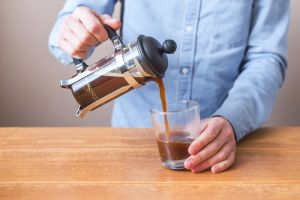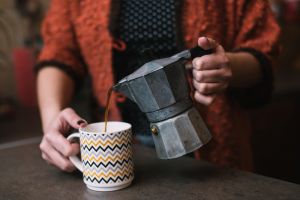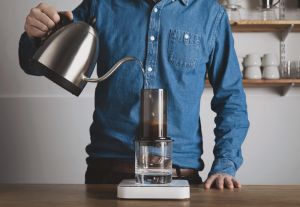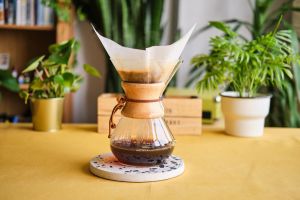Making coffee is a very inflexible process for a lot of people, as a good cuppa can be the difference between starting the day off right or setting yourself up for a midday slump. Whether it’s a French press, stovetop Moka pot, or even a pod machine, many of us are stuck in our ways about how we make our coffee at home. While there’s nothing wrong with having a favourite way of doing it, we often tend to overlook (or ignore) other ways of making coffee, even if they could be easier, or cheaper! So to help you get a jumpstart on the day, Canstar Blue has decided to compare some of the more popular ways of making coffee at home to see what the differences are, and what you’re potentially missing out on. Read on to find out the best ways to make coffee at home.
Coffee body and clarity: Something to note
It may come as a disappointment to some that no one way of making coffee is better than the others in terms of the coffee they produce, but at least it’s rather easy to explain why. There are two things most people will look for in a cup of coffee – body (i.e. the consistency and mouthfeel of the coffee) and the clarity of flavour (relatively self-explanatory). The annoying thing is that no one method of brewing coffee provides both of these characteristics to the extent that a coffee drinker at home might desire. Any given method is either a trade-off of one for the other or a balance of the two that doesn’t quite have enough of either. But like with most things, a bit of trial and error, and even trying all of the methods listed below, may produce the best cup of coffee you’ve ever had. And if you’re still not getting the usual buzz, why not try a new type of coffee? After all, you may find your new favourite.
How to make coffee at home
There are a number of ways to make coffee at home, each requiring a different level of attention and preparation. The ways to make coffee at home explored in this article include:
- French press
- Moka pot
- Aeropress
- Chemex
Read on below to find out what each method entails, and what the end product should be.
French press

One of the more tried-and-true methods on this list, many homes have got a French press (also known as a coffee plunger) lying around somewhere, even if they don’t use it too often. It’s a favourite of many for a few reasons, the main one being that the French press is an incredibly forgiving way of brewing coffee. It’s quite hard to make yourself a bad cup of coffee using one (although we’re sure you could if you tried hard enough). The French iress is the best option for those who value mouthfeel highly, as the more rustic filters in a French Press don’t quite filter out those tiny little micro-particles found in ground coffee. This result is an ever-so-slightly thicker cup of coffee.
However, this is also the main disadvantage of the French press because there’s a fine line between better mouthfeel and muddiness, and it’s rather easy to cross that line. On top of that, if you’re using a coffee blend with slightly more complex flavours, at least a few of them will get lost in the French press. Unfiltered coffee like that made with a French press is also higher in cafestol, which can raise levels of serum cholesterol in the body.
How to make a coffee with a French press
To make a coffee with a French press, first, take the plunger out of the container, and then add your ground coffee. Then add water that’s just off the boil, give it a quick stir, and then allow to brew to sit for around four minutes (or to your preferences), before plunging and serving up a cup. How much water you add to the plunger will depend on not only the size of the plunger itself, but your coffee preferences and how many cups of coffee you’re making. As a general rule of thumb though, most coffee enthusiasts recommend using about 60g of coffee grounds per litre of water.
Moka pot

The second-oldest way of making coffee on this list, (the French press beats it by a few years), the Moka pot (alternatively known as a stovetop coffee maker) is a classic Italian invention which will make you something very similar to espresso. However, while coffee made using a Moka pot will more or less look and taste like espresso, it’s technically not due to one technicality – the Moka pot uses roughly one to one-and-a-half bars of pressure to brew coffee, whereas espresso, by definition, requires roughly nine bars of pressure to extract. However, this is definitely only a technicality. Use a Moka pot properly and it’ll be hard to tell the difference between Moka pot coffee and espresso.
Using a Moka pot can initially be quite fiddly and take some time to get right, as your gas stove will likely give you a bit of variability, meaning you can quite easily burn your coffee, or under or over-extract it. As with many things, practice makes perfect.
How to make a coffee with a Moka pot
To make a coffee with a Moka pot, pour water into the base of the brewer, before inserting a filter and your ground coffee. Screw the top on and turn your stove on, before removing the pot once you hear noises, and serving carefully (as the metal pot will be hot to touch).
Aeropress

The Aeropress is a slightly more recent innovation in the coffee field, and it’s one that’s gaining much fanfare due to its ease of use and compact design. It uses a paper filter in order to provide a much ‘cleaner’ cup of coffee, being completely free of micro-particles and sediments.
However, the Aeropress does come with a few drawbacks. The first one is that its aforementioned compact design means you can only make one cup of coffee at a time, making it less than ideal for parties or company. The other commonly cited issue is that the complete removal of all sediment and oils found in ground coffee results in a cup that is almost ‘too clean’, being too thin for some. And, as with most methods of brewing coffee at home, it takes some fiddling and experimenting to figure out how to use it just right.
How to make a coffee with Aeropress
To make a cup of coffee with the Aeropress, simply place the press onto your mug, insert a paper filter into the base along with your ground coffee. From here, add water just off the boil and stir, before pushing the plunger down about a minute or two later, depending on your preferences and how strong you want your coffee.
The Chemex

The Chemex has recently made a resurgence in coffee snob circles but has actually been around since the early 40s. It’s a form of pour-over coffee, but differs from the standard pour-over in two ways – it uses much thicker filter papers, and it’s a slightly different shape from most pour-over containers. Its popularity comes from its ability to make an incredibly clean cup of coffee with no bitterness or excess acidity, with the thicker filter paper ensuring no sediment gets through.
The flipside of this coin is that the thicker filter paper also filters out the oils found in coffee, which can result in rather thin coffee, and remove some of the more complex flavours of the coffee. Its shape can also make it hard to clean thoroughly, although if you rinse it immediately after use that should be sufficient.
How to make a coffee with Chemex
To brew a coffee with Chemex, insert the filter paper into the Chemex, and rinse with hot water (discarding the water afterwards). Add your coffee grounds, and gently pour water just off the boil onto the coffee, stirring lightly as you go. Once you’ve added all of the water, remove the filter paper and pour your coffee into a cup.
Tips for making a good cup of coffee at home
We all may think we know how to make a top-notch cup of coffee, but with so many ways to make a cuppa, are there a few areas that you can improve on to really bring that coffee to life? Some potential tips include:
- Use quality coffee beans: They’re the base of what you’re working with, so if you want quality coffee, you’ll need quality coffee beans. Try a few different types and flavours, as you may find a new bean that gives you that extra kick or suits your tastebuds more.
- Grind only what you need: Grinding up more beans than you need can impact how fresh the coffee grind is. Grinding as you go can help ensure your coffee is fresh every time.
- Properly store your coffee: As with grinding only what you need, by properly storing your coffee, you can help keep your coffee fresher for longer.
- Clean your coffee maker: As with anything in the kitchen, ensuring that your utensils, machine and tools are all clean before use can help you avoid tasting anything particularly nasty (unless you burn your coffee, that’s on you).
- Experiment with spices and frothed milk: By adding extras like nutmeg, shaved chocolate or even frothing your milk instead of pouring it in straight from the container can all impact the taste and quality of your coffee. Of course, these are a little bit more effort, but if you’re big on taste, they may be well worth going the extra mile for.
What’s the best method for making coffee at home without a machine?

For many households, a cup of coffee is an important part of the daily routine, but when it comes to figuring out the best method for creating a cup of coffee, it ultimately comes down to your personal preferences. Your preferences for taste, texture, coffee strength, aroma and all manner of other factors will play into which method may end up being the best option for you, along with how much effort you’re willing to put in to making a coffee, and how much money you’re fine with spending on a new coffee machine or contraption. Of course, there’s no pressure to not use a machine, as there’s plenty of options available on the market to allow you to simply enjoy your warm cuppa in the morning.
Read more: A guide on the best portable coffee machines
Looking for an easier way to make coffee?
Check out our consumer ratings on coffee machines to see which brands may be your next coffee date.
Espresso Coffee Machine ReviewsOriginal Author: James Hurwood.
Picture credit: Olena Yakobchuk/Shutterstock.com, M.iskandarov/Shutterstock.com, Viki2win/Shutterstock.com, BublikHaus/Shutterstock.com, Tarik Kaan Muslu/Shutterstock.com, Farknot Architect/Shutterstock.com.



Share this article